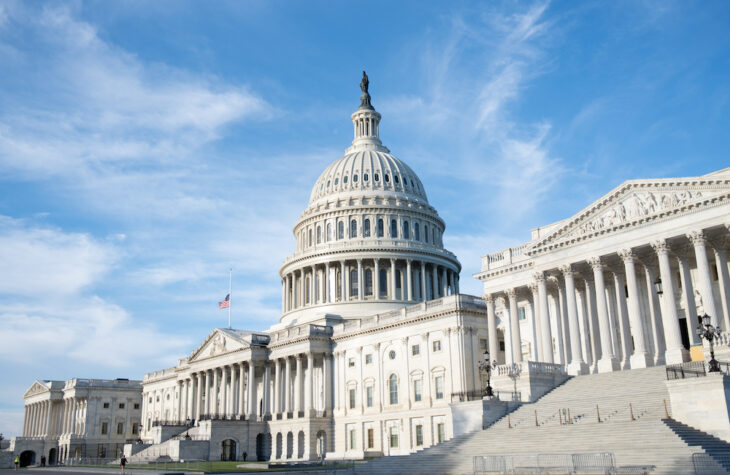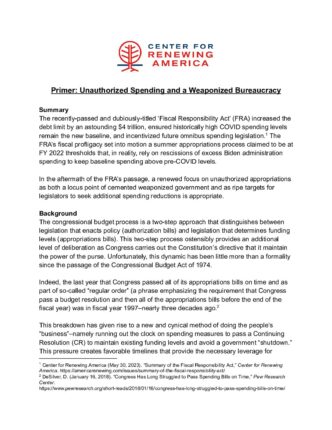
Primer: Unauthorized Spending and a Weaponized Bureaucracy

Summary
The recently-passed and dubiously-titled ‘Fiscal Responsibility Act’ (FRA) increased the debt limit by an astounding $4 trillion, ensured historically high COVID spending levels remain the new baseline, and incentivized future omnibus spending legislation. The FRA’s fiscal profligacy set into motion a summer appropriations process claimed to be at FY 2022 thresholds that, in reality, rely on rescissions of excess Biden administration spending to keep baseline spending above pre-COVID levels.
In the aftermath of the FRA’s passage, a renewed focus on unauthorized appropriations as both a locus point of cemented weaponized government and as ripe targets for legislators to seek additional spending reductions is appropriate.
Background
The congressional budget process is a two-step approach that distinguishes between legislation that enacts policy (authorization bills) and legislation that determines funding levels (appropriations bills). This two-step process ostensibly provides an additional level of deliberation as Congress carries out the Constitution’s directive that it maintain the power of the purse. Unfortunately, this dynamic has been little more than a formality since the passage of the Congressional Budget Act of 1974.
Indeed, the last year that Congress passed all of its appropriations bills on time and as part of so-called “regular order” (a phrase emphasizing the requirement that Congress pass a budget resolution and then all of the appropriations bills before the end of the fiscal year) was in fiscal year 1997–nearly three decades ago.
This breakdown has given rise to a new and cynical method of doing the people’s “business”–namely running out the clock on spending measures to pass a Continuing Resolution (CR) to maintain existing funding levels and avoid a government “shutdown.” This pressure creates favorable timelines that provide the necessary leverage for enacting a massive omnibus appropriations spending bill, usually during the Christmas holidays when few Americans are paying attention and the strong allure of jet fumes percolates throughout the House and Senate chambers.
The result is the promulgation of hundreds of billions in spending on unauthorized appropriations without the appropriate oversight of Congress.
From a budget perspective, unauthorized appropriations are federal funds appropriated for specific programs, agencies, or departments that have lapsed and not been reauthorized with specific congressional approval. In FY 2022, Congress spent over $460 billion on unauthorized programs and laws, with nearly half of such spending going to programs that expired a decade ago. This constituted nearly 30 percent of the discretionary budget during that fiscal year–a percentage that has increased drastically since the turn of the century.
Government on Autopilot
The degree to which the federal government now runs automatically–with or without congressional approval–is inextricably tied to the increasingly woke and weaponized bureaucracy waging war on the American people. As agencies, departments, and programs continue to receive increasing levels of funding without authorization from the very branch of government constitutionally obligated to provide such legitimacy, the rise of an unaccountable “fourth branch of government” in the bureaucracy is inevitable.
Below is a chart showing some unauthorized departments, agencies, and programs and a non-exhaustive list of high-profile woke and weaponized activities they pursue.
| Name | Last Major Authorization | Woke and Weaponization Activities |
| National Institutes of Health (NIH) | 2007 | Funded “gain-of-function” researchTouting gender mutilation surgery in coordination with WPATHTaxpayer-backed fetal tissue harvestingGrants pushing health equity, DEI, radical gender theory |
| Department of Energy | 2005 | Pursuing an “equitable clean energy agenda” embracing climate zealotry to achieve “net zero” emissionsPIER plans forcing grant applicants to commit to incorporating DEI in their research projectsOffice of Economic Impact and Diversity advancing destructive “energy justice” initiatives to destroy reliable and cheap sources of energy |
| Department of Justice | 2003 | Opened investigations into concerned parents at school board meetings as domestic terroristsTargets states that have banned gender mutilation surgery on minorsReimburses state and local jurisdictions that refuse to follow federal immigration lawEngages in environmental justice activities to advance equityWeaponized Community Relations Service to foment race essentialism and pits citizens against law enforcementGrants pushing DEI, ending cash bail, promoting pro-criminal policies, and centering race equityPersecution of January 6 protestors |
| Bureau of Alcohol, Tobacco, Firearms, and Explosives (ATF) | 2003 | Criminalization of pistol braces infringing on constitutional rights of law-abiding citizens.Operation Fast and Furious equipped violent Mexican drug cartels with weapons at the cost of American lives |
| Federal Bureau of Investigation (FBI) | 2003 | Weaponized FACE Act to arrest and intimidate pro-life activistsTurned a blind eye to violent leftwing attacks on crisis pregnancy centers and churchesPersecution of whistleblowers |
| Department of State | 2002 | Hundreds of millions in grants pushing radical gender theory, Critical race theory, LGBTQ activismEquity Action Plan pushing race essentialism as a key part of U.S. diplomacy“Family planning” agenda aimed at pushing abortion and LGBTQ activism in poor and developing countriesFacilitating open borders policies through the Migration and Refugee Assistance programs |
| National Oceanic and Atmospheric Administration (NOAA) | 1993 | Advancing DEI and race essentialism as part of its fisheries management programClimate Prediction Center advances radical climate zealotry |
| Centers for Disease Control and Prevention (CDC) | Never | Targeted American citizens for COVID “disinformation”Spent $6 billion on health equity initiatives viewing care through a racial lensGrants pushing health equity, DEI, and radical gender theory |
Vast swaths of the discretionary budget have not received congressional approval or contain lapsed authorizations altogether. This includes not just the State Department and Department of Justice listed above but also smaller entities like the Federal Elections Commission (FEC), which has not received authorization since 1981, and the U.S. Trade Representative (USTR), which has not received authorization since 2004.
These unauthorized entities are not limited to departments and agencies either.
A recent Congressional Budget Office report showed that nearly 1,100 programs continue to receive funding despite lacking current authorization from Congress. This includes programs like Head Start, a government-run preschool program within the Department of Health and Human Services (HHS) known to produce negative participant outcomes, which has not been authorized since 2007. Neither has the Low-Income Home Energy Assistance Program (LIHEAP), which technically expired in 2007 and contains nearly $4 billion in wasteful spending.
One of the few remaining parts of the discretionary budget that still receives regular authorizations and appropriations is the Department of Defense through the annual National Defense Authorization Act (NDAA). However, even that process has increasingly become a rubberstamp exercise more than an oversight endeavor, with committee members taking the path of least resistance and slow to reorient America’s national defense posture toward new and emerging threats like communist China.
Precedents set over decades regarding congressional unwillingness or inability to authorize discretionary spending ultimately harm the very working families and households such programs are supposed to benefit. Without regular oversight and approval, the federal bureaucracy becomes an entity of its own–disconnected and increasingly disdainful of the people it is meant to serve.
It is past time for that to change.
Policy Approaches Needed
As Congress considers appropriations bills and engages in committee markups, it should take advantage of new House rules that empower members to target unauthorized appropriations in the short term and move toward more permanent changes to curb government on autopilot.
Points of Order: The rules package negotiated during the Speaker battle in January includes a new point of order to target unauthorized appropriations. Specifically, the new mechanism allows a member to raise a point of order on an unauthorized appropriation and, if sustained, reduce the spending for that program to levels consistent with the last time it was authorized. Assuming the numbers from the latest CBO report, this gives lawmakers, in theory, over 1,000 opportunities to raise points of order to reduce spending.
The reality is that many–if not most–of the appropriations bills are unlikely to come to the floor and will likely be rolled into an omnibus at the end of the year. While that practically limits the overall opportunities to target unauthorized programs, there will likely be dozens, perhaps hundreds, of opportunities to target spending on autopilot.
Floor Amendments: The House Rules Committee should ensure that limitation amendments targeting such programs remain in order for up-and-down votes on the floor as well as any amendments that reduce spending to pre-COVID levels as opposed to the inflated levels sought under the FRA.
Executive Power: While not presently tenable, future presidential administrations should exercise the full scope of executive power to deal with unauthorized appropriations. This includes a promise to veto spending for unauthorized programs, robust usage of the rescission authority embedded in the Budget Act of 1974 to target such “zombie” appropriations, and muscular action to fire bureaucrats and superiors in agencies that lack congressional approval or reauthorization as part of official administration policy.
Conclusion
The federal bureaucracy has transformed into an unelected and unaccountable fourth branch of government–consuming ever-larger amounts of taxpayer resources while displaying increasing hostility toward the very citizens that give such agencies legitimacy. It is imperative that Congress lay the foundation now to target unauthorized appropriations for much-needed spending reductions, end the administrative state on autopilot, and provide the next President with a clearer pathway for bringing a weaponized bureaucracy to heel.
Endnotes
1. Center for Renewing America (May 30, 2023). “Summary of the Fiscal Responsibility Act,” Center for Renewing America. https://americarenewing.com/issues/summary-of-the-fiscal-responsibility-act/
2. DeSilver, D. (January 16, 2018). “Congress Has Long Struggled to Pass Spending Bills on Time,” Pew Research Center. https://www.pewresearch.org/short-reads/2018/01/16/congress-has-long-struggled-to-pass-spending-bills-on-time/
3. Tollestrup, J. (February 3, 2016). “Spending on Unauthorized Programs,” Congressional Research Service. https://crsreports.congress.gov/product/pdf/TE/TE10005/3
4. Congressional Budget Office (August 2022). “Expired and Expiring Authorizations of Appropriations for Fiscal Year 2022,” Congressional Budget Office. https://www.cbo.gov/publication/58443#_idTextAnchor006
5. Congressional Budget Office (January 13, 2023). “Expired and Expiring Authorizations of Appropriations for Fiscal Year 2023,” Congressional Budget Office. https://www.cbo.gov/publication/58170
6. Ibid.7. Center for Renewing America (December 7, 2022). “A Commitment to End Woke and Weaponized Government,” Center for Renewing America. https://americarenewing.com/wp-content/uploads/2021/04/Budget-Center-for-Renewing-America-FY23.pdf




